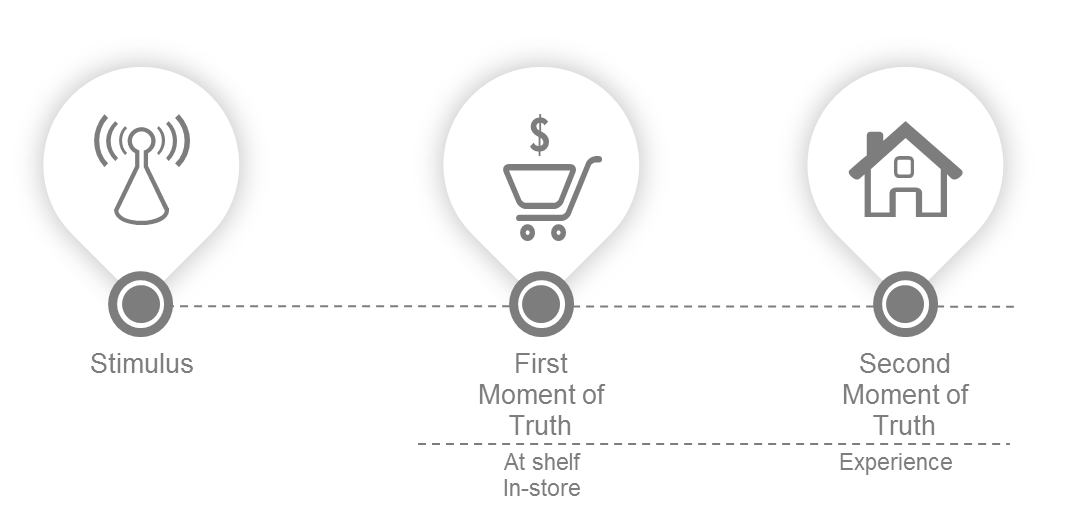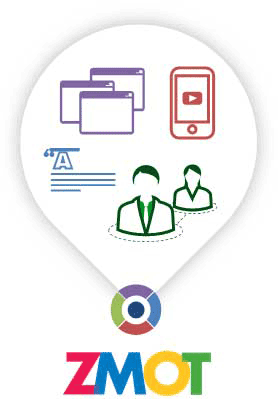Ok, so there’s a double-meaning in the title – punning (as usual) on Google’s ZMOT – Zero Moment of Truth philosophy, and the concept of truth in advertising. But the literal interpretation of this phrase is definitely one I can get behind. There is essentially no truth in advertising – the moments of truth start when real people start interacting and the genuine marketers (like us!) who want to reach them, and are looking for those moments of truth to happen.
In 2005, Proctor & Gamble was cited in a Wall Street Journal article, related to FMOT, otherwise known as the “first moment of truth” – a concept developed around in-store merchandising. The premise centres around the 3-7 seconds that a consumer takes to form an impression of product, and the epiphany (“moment of truth”) that marketers want to create in that short timespan.
Fast-forward to 2011, and as anyone knows, we’re firmly in the golden age of Google. Jim Lecinski takes the moment of truth concept and Google-izes it, opining that the Zero Moment of Truth (ZMOT) has now been inserted into buying decisions. The concept is (at first glance) intended to apply to consumer marketing but the implications and indications are much more far-reaching. Lecinski published an e-book about ZMOT – which is actually pretty neat and worth a read. Of course, being Google, they didn’t stop there. In fact, in the almost 2 years since the e-book, it’s expanded and been revised, adapted, morphed, re-worked, updated, etc. There’s even a ZMOT toolkit. Cripes, these guys are pretty darned good at proliferating messages which encourage us to spend more (and more) dollars with them. The thing is – as we know very well, those dollars totally work if you put the work into them (insert promotional phrase here).
The Zero Moment of Truth has the basic premise that at any time in the process, a consumer/buyer/party can interrupt the whole process, using technology to refer to some piece of content or to have an interaction through the use of technology that could make a dramatic impact on their decision-making. An online review, a text from a friend, someone’s Facebook post, a video of someone prominent using a product (or service), etc.; there are literally thousands of possible instances that can contribute to the buyer’s feelings of confidence (or lack thereof) in what they’re about to do.
Anyway, I’ll stop blathering on with the context and background. There’s something truly important to be learned here and it’s not something that suffers from the limitations of time, nor thought. Maybe I’m totally drunk on the kool-aid here, but I honestly think there’s a huge dose of truth in this advertising. The premise of ZMOT is all about moving the goalposts of both the original P&G model, and the whole concept of what call the “Traditional Model of Mental Marketing.” Here’s a diagram/excerpt:
The traditional model’s chronology goes like this; the advertising (Stimulus), Packaging/Display (FMOT), and then the second moment of truth (the experience itself). That all makes sense, (not actually too hard to understand if you’ve ever been grocery shopping) – saw the commercial, saw it in the store, bought it. One of the reasons that I’m enamoured of Google’s ZMOT – is because it’s not like it’s specific to Google. Of course, they’re doing what they can to leverage it for their own means. The simple reality is that they’re still so dominant in search, when we talk about web we’re really most often referring to Google. That said, the ZMOT is so disruptive that they’ve totally got a point. Can you think of the last time you bought something that was more than $50, when you didn’t look it up online in some form or another? Or that you didn’t text or email your friend about? I have long held that any transaction of any kind is an emotional decision. Whatever happens, before and during the process, when you go to enter your PIN number or sign something, you have to feel emotionally comfortable with what you’re signing up for.
So, texts, emails, reviews, posts, etc.; these are all representative of ZMOT. They’re all things that pervade what Google is doing as well with advertising, organic – everything really. The Zero Moment of Truth – it’s you stopping at the grocery store, then sending a Facebook message to your friend because you could swear he told you about an awesome new dog food that his picky-as-hell dog loved like crazy. ZMOT in action. It’s about Social Media (friends, reviews, etc), it’s about Organic Search (“Google it”), it’s about Paid Search (meet them halfway), it’s about Mobile (I’m texting Jan right now to ask about this), it’s about video (let’s see what that reality-show chef I like uses for this). Can you imagine if the P&G merchandising person had to include all of those elements in an in-store display? Would make for some good grocery-comedy, and probably one heck of a big box store with only one product in it. Part of the point is, even though Lecinski puts ZMOT between Stimulus and FMOT, the reality is much more dynamic. Your client could be literally sitting down to sign the papers when he or she hears back from that person she knows, who’s getting back to her because he owned the same kind of product. Part of the reason that it’s so disruptive, is because you can’t predict when and where it’s going to happen. As a marketer, there is no longer such a thing as “don’t confuse the sale with the delivery.” If you aren’t working in every instance of your product (or service really) to uphold the standards of quality and value, it’s only a matter of time before the ZMOT nails you. You have to take care of the whole! Conversely, if you are doing those things, the ZMOT could be a key to your success.
What does it all mean, in practical terms? Well, I’m a self-interested blogger here. This is our website, and we provide online marketing services. Surprise! ZMOT totally relates to what we do with online marketing, and what we can help you to do. Listen, I don’t want to be overly promotional here. Not the point of a blog. I really don’t want to be hard-pitched to in anyone’s blog, and neither should you. But I do want to try and inform; try and distill what we know about online, and most of all, try and give you a bit of value, whether you end up working with us or not.
There are many things in what we do as online marketers, that help you leverage these zero moments of truth, and make substantive connections to your markets, whatever those may be. I’ll make some connections on the B2B side of things as well, because Google was also good enough to take this way beyond people buying diapers. Damn, those folks are smart! If I break it down and ask myself, where do the ZMOTs come from? Just improvising a list here, would love to hear your thoughts:
- Product and service reviews
- Online display traffic
- Mobile communications
- Google AdWords traffic (Paid)
- Blogs
- Social media (Pinterest, Facebook, etc.)
- Community participation/involvement
- Customer interaction (phone, live chat)
- Non-traditional offline (NewAd, QR Codes)
- Traditional offline advertising
- Video content
One of the things I like best about the concept of ZMOT – you can’t fake it. Well, let’s be honest – of course you can fake it, but you won’t be getting away with it for long. Whatever the ever-changing face of the web looks like, we’re all being pulled to be better and ZMOT is a double-edged wake-up call. If you give a crap about what you do, ZMOTs will show that, if you’ve got your eyes off the ball – get prepared for the ball to hit you in the face. As online marketers, Google drives us and our customers to deliver content as fresh, relevant, and local as possible. ZMOTs, and their actual adoption by customers, (whether they are consumers or not) reinforce that. I realize this is a pretty convenient position for a self-interested party like me to talk about. There’s a lot of stuff that we do to help put our clients into a position where they aren’t scared of ZMOTs, but instead look at them as an opportunity.
So, what is there in terms of the Bluetrain online marketing services, that enables or takes advantage of ZMOTs?
I suppose I could go on (and on) about how each of these discrete services contribute to ZMOTs, but I’m not really writing this blog to bend everything we do at Bluetrain into the enablement of ZMOTs. Suffice it to say that almost any engaged client of ours is and should be trying to make this happen, through almost every service that we offer. I couldn’t fault someone for finding that overly promotional, a little crass even, but for anyone who knows me it would be clear that I truly believed that to be the case. I would be really interested to hear some comments on this. I realize it’s been a while since ZMOT was introduced, but it is here to stay, you simply can’t argue with the power of the genuine-web.

